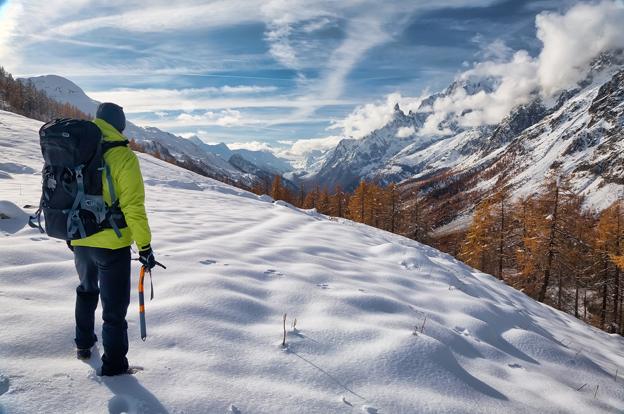There’s no shortage of options for the mountain lover in Italy. From north to south, il bel paese features mountain resorts to be enjoyed both in winter and summer, with a variety of beautiful landscapes, from alpine lakes to magical forests, dotted with charming historic villages and, being Italy, the chance to enjoy gourmet dishes of the local tradition. Outdoor activities abound, making the mountains of Italy the ideal destination for those who want to combine sports, relax, culture and food delights.
The Alps
The Alps, Europe's highest and most extensive mountain range, stand at the northern end of Italy, marking a geographical boundary. The majestic alpine area traverses several northern Italian regions: Aosta Valley, Piedmont, Lombardy, Trentino Alto Adige, Veneto, Friuli Venezia Giulia.
The Alpine region has a strong cultural identity. Tourism has become the major industry, but the traditional culture of farming, cheesemaking, and woodworking remains strong in Alpine villages.
At 4,810 meters (15,781 ft), Mont Blanc, which spans the French-Italian border, is the highest mountain of the Alps, followed by Monte Rosa, at 4,634 meters (15,200 ft). Both Mont Blanc and Mont Rose stand in part in the region of Aosta Valley, the smallest, least populous, and least densely populated region of Italy. Cervino and Gran Paradiso, also among the Alps’ highest peaks, are in the Aosta Valley. Gran Paradiso is also the name of Italy’s oldest National Park, where it is still possible to see animals, such as ibex, chamois, eagles and marmots, in their natural habitat.

A number of outdoor activities can be enjoyed here. The three valleys of Ayas, Gressoney and Valsesia are the hub for one of Italy’s largest ski resorts. Cervinia, Courmayeur and Pila are the region’s most popular resorts. For those interested in history, there are several examples of the Roman influence on this territory, beginning with the capital Aosta, a mix of Roman and medieval history, and the 1st-century BC Roman bridge, over which the old consular road to Aosta used to pass. A major tourist attraction is the Fenis Castle, an imposing medieval fortress.
In the region of Lombardy is beautiful Valtellina, a favorite destination for lovers of winter sports. Here, you can actually ski all year round on the slopes of the Stelvio, which is known as the “university of ski” because, from May to November, ski champions come to train. The “Skiarea Valtellina” includes four major ski resorts, Alta Valtellina, Aprica, Valmalenco e Valchiavenna, and their internationally renowned mountain towns - Livigno, Bormio, Santa Caterina Valfurva, Madesimo, Chiesa Valmalenco, Aprica and Valgerola – for a total of 400 kilometers of slopes.
Standing at one of the northernmost points in Italy is Livigno, whose temperatures are often polar in winter. Livigno, on a plateau surrounded by mountains in the heart of the Rhaetian Alps, is a coveted destination for a ski vacation, thanks to its excellent ski facilities and its altitude - the town is at 1,816 meters with slopes reaching up to 2,800 meters – which makes for ideal snow conditions.
In Lombardy and part of Trentino Alto-Adige is the Stelvio National Park, the largest in Italy. Founded in 1935, the park is home to a variety of wildlife. A popular town here is Bormio, famous for its thermal waters used since Roman times. And those who love biking - and a challenge! - should not miss the chance to bike the Stelvio Pass, the highest paved mountain pass in the Eastern Alps, often featured on the Giro d’Italia.

Proceeding west along the Alps you will find the “most beautiful work of architecture ever seen”: the Dolomites. Covering an area of 141,903 hectares encompassing three regions, Trentino Alto Adige, Veneto and Friuli Venezia Giulia, and five provinces, Trento, Bolzano, Belluno, Pordenone e Udine, the majestic Dolomites feature 18 peaks rising above 3,000 meters. The mountain groups include the Brenta Dolomites, the Catinaccio and the Latemar, between Alto Adige and Trentino; the Dolomites of Sesto and the Pale di San Martino; the massif of Marmolada, Pelmo and Croda da Lago, and the Friulian Dolomite chain, at the easternmost point.
The chain’s westernmost point is the Brenta Group, where you can find the “queen of the Dolomites”: chic Madonna di Campiglio, one of Italy’s most important ski resorts. The area features more than 60 km of slopes and 20 ski lift facilities. Here, the “3-Tre” slope is a favorite; the name refers to the "Three Races of Trentino", special slalom contests taking place during the World Cup of Alpine Skiing. Another favorite is the steep "Spinale Direttissima".

Another popular area for winter sports lies east of Trento, between the Val Cismon, Val di Fiemme and Val di Fassa, with famous mountain resorts like San Martino di Castrozza, Predazzo, Cavalese, Moena and Canazei, surrounded by the gorgeous summits of Mounts Sella, Sassolungo and Marmolada.
In the northernmost section, in the Province of Bolzano, is Val Gardena with Ortisei, Santa Cristina and Selva. Here you will find one of the most spectacular and famous downhill ski slopes in the world, where the World Cup in Freestyle Skiing is held every year: the Saslong. The Saslong is part of the Dolomiti Superski, one of the largest ski areas in the world, passing through Val di Fassa, Val Gardena and Val Badia: 1,220 km of slopes, where you can use the same skipass. One of the areas that make up the Dolomiti Superski is the fantastic Plan de Corones, definitely one of the top ski resorts in Europe.
While the Alps are indeed Italy's most popular destination for mountain fun, beautiful mountain areas can also be found in central and southern Italy, and we'll explore them in Part Two.
And if visiting the mountains isn't enough for you, consider investing in a property.




